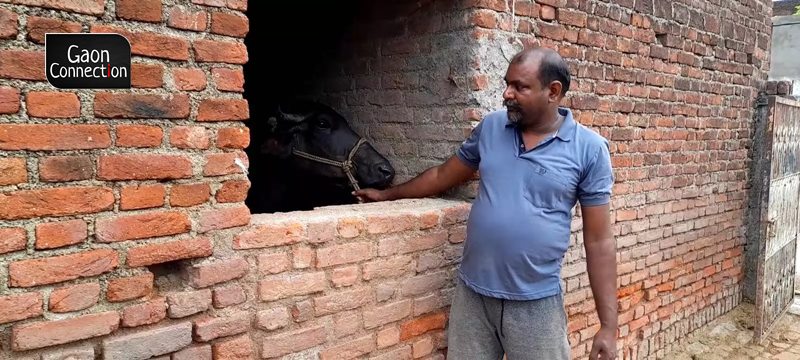What began as a desperate measure to provide nourishment to his ailing mother 27 years back has now blossomed into a booming enterprise whose monthly revenue can easily fascinate the service class urban dwellers.
Such is the success story of 45-year-old Khushihaal Kushwaha who lives in Satna district’s Dhawari locality in Madhya Pradesh .
“This began about 27 years ago when my mother was down with malaria. And my father had recently retired from his job at the railways and received a pension of about Rs 2,600 rupees for two months. I used this money to buy my first cow. As my financial condition was far from good, I used to sell some milk to meet the expenses for my mother’s medicines,” Kushwaha told Gaon Connection.
“Then it occurred to me to turn this into a full-time occupation, and I continue doing it until today,” Kushwaha further said.
Kushwaha presently owns around 150 cattle. The cows are from the Gir and Sahiwal breeds, while the buffaloes are Haryana’s famous Murrah breed. Kushwaha sells 250-300 litres of milk every day and earns between Rs 100,000 to Rs 200,000 per month.
Also Read: Amul hikes the price of its milk by Rs 2 per litre — will the dairy farmers benefit?
The price of milk ranges between Rs 50-60 per litre. After deducting the house and dairy costs, he makes a profit of around Rs 50,000 to Rs 60,000. According to Kushwaha, milk production drops in the summer and increases in the winter.
Originally, a resident of Ahikoura village in Chandauli district of Uttar Pradesh, Kushwaha’s father used to work in the railways in Satna and after his retirement, he settled there. Kushwaha purchased a house in Satna, a dairy, and 15 acres of property in a nearby village with profits from his dairy business.
Kushwaha dropped out of class 11th due to financial difficulties. He wanted to study more, was interested in sports, and aspired to play for his nation. Financial situation at home demanded him to sacrifice those dreams and he began rear cattle, got fascinated with it and his passion for cows grew with every passing day.
Separate arrangements for milch and dry cattle
Kushwaha told Gaon Connection that milch cattle produce milk only for a few months after giving birth to calves, and keeping and feeding them in the city is an expensive undertaking. Hence he has also built a dairy in the village where animals that do not produce milk are kept and cared for.
“The cows that give milk are kept in the city,” he said. There are roughly 60 milch cattle in the city. The remaining animals are housed in the gaushala (cattle shed) , which was established near the village of Hardokhar, some seven kilometres from the Satna city. Dairy operations are located in the city to ensure that customers have easy access to milk.
Family comes together to manage the dairy
“The milch cows and buffaloes are given six kilogrammes of grain, 25 kilogrammes of green fodder and chaff in the morning and evening, totalling an expense of around 250 rupees per animal per day,” Kushwaha told Gaon Connection. While the remaining dry animals need feed that costs about 125 to 130 rupees per animal per day.
Also Read: With cattle markets shut and the monsoon around the corner, Maharashtra farmers are in a fix
In his dairy, there are four-five workers to feed the animals, milk them, and clean the cowshed. Also, his entire family is involved in this activity, from the elderly parents to the young kids of the household and they all try to assist Kushwaha in his enterprise.
The dairy is a source of income for his family and has provided him success and recognition for his contribution to the white revolution. Many awards and distinctions have been bestowed upon him and his family members, including the state government’s Gopal Award for milk production.
“Me, my wife and younger brother have received the Gopal Awards,” said Kushwaha. “We secured the first position at the development block level and third place at the district level in 2017 from the Animal Husbandry Department of the Madhya Pradesh Government. We received this recognition for our Sahiwal cow,” he added.
“Also, in 2018, my younger brother Yashwant won the district level first award, and my wife Prema Kushwaha won the block level second prize in 2019. But since last year, the awards have not been announced,” Kushwaha told Gaon Connection.
Indigenous fodder for cow and buffalo feed
Fodder and chuni-bran (ratib) for cows and buffalo contribute to the significant cost of indigenous dairy farm operations. So, Kushwaha grows the feed on a significant portion of his estimated seven hectares of land. Instead of chemical fertilisers, this grass is fertilised using cow dung manure from both dairies.
He explains, “Every day, around one trolley of cow dung that is collected from both cowsheds, is utilised on the fields, so they do not need to buy manure from the market. In the summer, they grow Chari for cows and buffaloes, and in the winter, they grow berseem.”
Dairy farming in India
India is the world’s largest milk producer, accounting for 23 per cent of the worldwide production. According to the National Dairy Development Board, milk output in India was 55.6 million tonnes in 1991-92, but it rose to 198.4 million tonnes in 2019-20. In 2030, milk demand is predicted to reach 266.5 million tonnes. India’s largest milk-producing states include Uttar Pradesh, Rajasthan, Madhya Pradesh, Gujarat, Andhra Pradesh, and Punjab.
Also, in the last five years, the country’s yearly milk output has soared by 6.4 per cent.
Read this report in Hindi



















